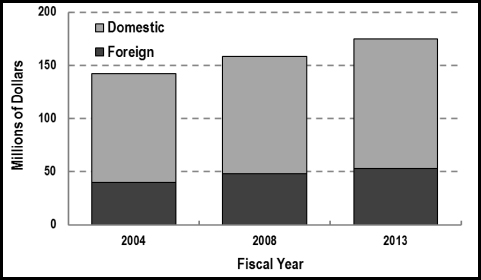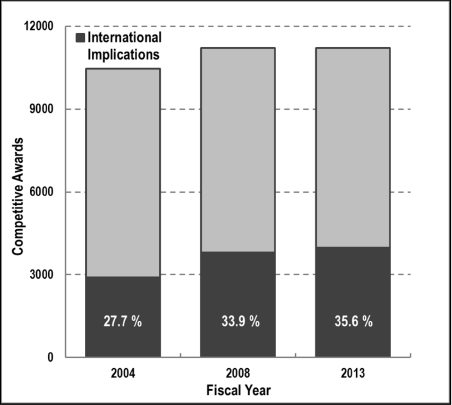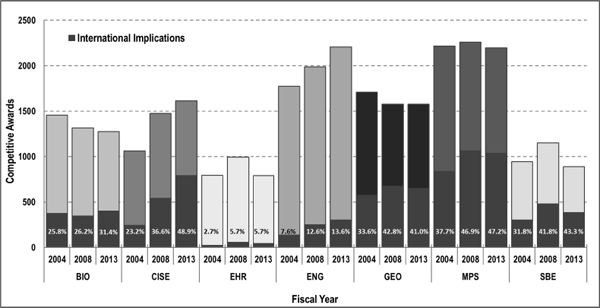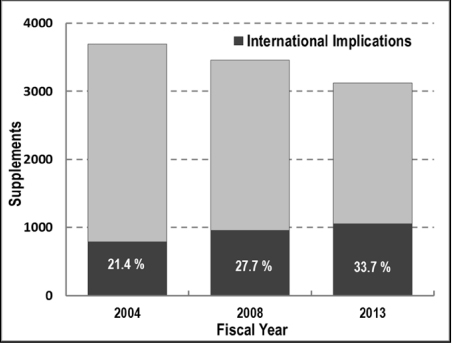APPENDIX K
INTERNATIONAL ENGAGEMENT ACTIVITIES OF THE NATIONAL SCIENCE FOUNDATION
The information in this appendix was provided by the National Science Foundation with major contributions from Arthur Fitzmaurice.
National Science Board Reports
| 2014: | Science and Engineering Indicators | |
| 2008: | International Science and Engineering Partnerships: A Priority for U.S. Foreign Policy and Our Nation's Innovation Enterprise | |
| 2002: | Toward a More Effective Role for the U.S. Government in International Science and Engineering |
NSF International Science & Engineering Partnerships with Foreign Funding Agencies & Institutions
Partnerships for International Research and Education (PIRE) is an NSF program that provides support to U.S. academic institutions to engage with foreign academic institutions in developing and advancing scientific knowledge and discovery across all NSF-supported fields of study. The primary objective of the program is to help US researchers (faculty and students) connect with cutting-edge research around the world. The program provides support to advance research agendas of US faculty and to provide international research experiences to students and early career researchers. NSF has established partnerships with foreign counterpart agencies to develop these partnerships. The NSF provides up to $5,000,000 of support over five years to the US side of the partnerships, and the foreign counterpart agencies provide support to the foreign side.
PIRE is currently undergoing an external evaluation by Abt Associates which is anticipated to be available in the coming year. Media highlights from PIRE programs [are available at http://www.nsf.gov/news/index.jsp?pims_id=12819&org=NSF]. As an examples of one project, “Developing Low Carbon Cities in US, China, & India” (IIA-1243535) brings together six US institutions and eight Asian institutions to design low-carbon, sustainable cities in the US, India, and China. Researchers are exploring how to best reduce greenhouse gas emissions, linking
this with broader sustainability goals, including economic development, pollution, and public health. The project is training nearly 100 students – across all three countries – and partnering with NGOs to translate research into action.
Award #1243535
PI: Anu Ramaswami, University of Minnesota Professor of Science, Technology, Public Policy
Countries: China, India, United States
Institutions: University of Minnesota, Yale University, Georgia Institute of Technology, National Center for Atmospheric Research, University of Colorado Denver, National Academy of Engineering Center for Engineering, Ethics & Society, TERI University, Indian Institute of Technology Kanpur, Tongji University, Tsinghua University, Chinese Academy of Sciences Institute for the Urban Environment
Disciplines: Engineering, Environmental Sciences, Industrial Ecology, Urban Planning, Public Affairs, Public Health.
NSF Award International Collaboration Data Metrics
Figures K-1 to K-4 have been reproduced from data provided by the National Science Foundation.

FIGURE K-1 NSF awards included $51.8M budgeted for foreign travel in FY2013. Foreign travel budgets increased 35 percent in the past decade, while domestic travel budgets only increased 23 percent.
SOURCE: Reproduced from data provided by the National Science Foundation.

FIGURE K-2 The number and proportion of competitive awards with international implications have increased in the past decade. Overall, 36 percent of the competitive grant proposals that NSF awarded in FY2013 had international implications.
SOURCE: Reproduced from data provided by the National Science Foundation.

FIGURE K-3 In FY2013, over 40 percent of the awards made by CISE, GEO, MPS, and SBE included international cooperative activities.
SOURCE: Reproduced from data provided by the National Science Foundation.

FIGURE K-4 Over the past decade, the number of supplements to competitive awards has decreased, but the number and proportion of supplements coded as having international cooperative activities have increased. Some of these are supplements for international travel not captured in the proposed award budgets.
SOURCE: Reproduced from data provided by the National Science Foundation.
This page intentionally left blank.






